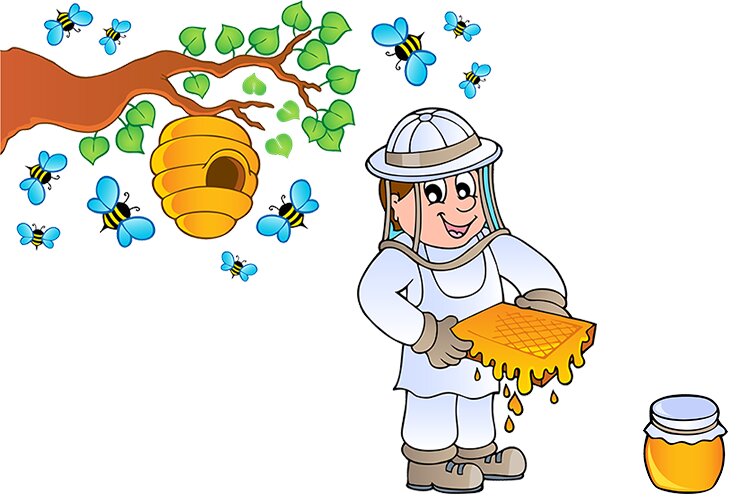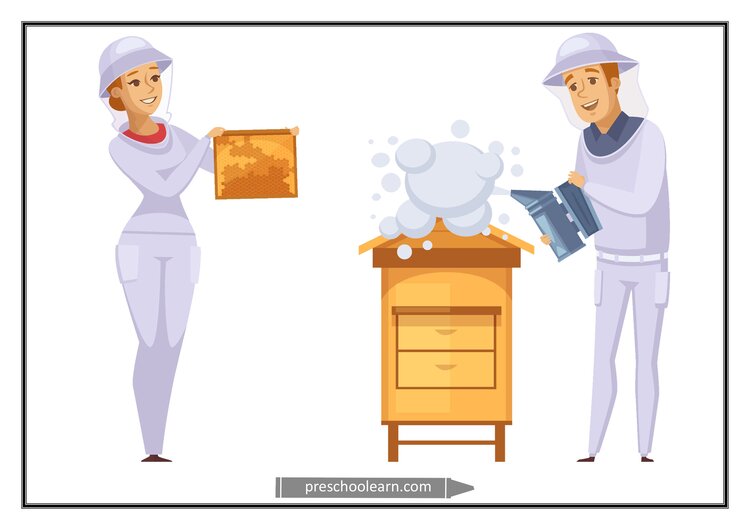Children will do a worksheet entitled ‘Delicious honey’ and taste various honey flavors. They will get to know about the process of making honey from a picture story entitled ‘How is honey made?’ and will watch an educational video to know how honey bees make honey. They will also learn about different products of bee origin.
Materials:
a nursery rhyme entitled ‘It’s morning’, a worksheet entitled ‘Delicious honey’, crayons, a song entitled ‘Honey bee’, different types of kinds of honey, bowls, teaspoons, a picture story entitled ‘How is honey made?’, a song entitled ‘Bizz Bizz Busy Bee’, an educational film entitled ‘How do bees make honey?’, ringos/sashes, classical music, picture cards with the products of bee origin, bell.
Activity description:
1. ‘It’s morning’ – greeting children with the nursery rhyme – children and their teacher sit in a circle. Teacher says the nursery rhyme and shows the correct movements. Children try to imitate them. Next, they try to say the nursery rhyme with their teacher.
It’s morning.
The sun is coming up. (raise hands up and wave fingers)
It’s morning.
It’s time to wake up! (stand up slowly)
It’s morning.
Let’s start a new day. (march in place)
Let’s work,
Let’s laugh and play! (laugh)
It’s morning.
There’s so much to do. (march in place)
Good morning friends! (wave to others)
Good morning to you!
2. ‘Delicious honey’ – introduction to the topic by the worksheet – teacher shows the worksheet and explains how they should do the task (color places by number with the right color). Next, teacher asks children to go to the tables and gives away the worksheets. During the task, teacher walks between the tables and helps children if they need it.
3. ‘Sticky hands’ – movement activity – children move in the kindergarten room to the song ‘Honey bee’. During a break, teacher says the name of the color and they have to find it in the kindergarten room and touch it. Continue it until the song is over.
4. ‘We taste honey’ – didactic and sensory activity – teacher says to children that they can taste various honey flavors. During tasting, teacher talks with children about the smell, taste and health properties of honey flavors. Information about them can be found here, here and here. Finally, teacher asks children which honey was the best for them and why.
5. ‘Sticky legs, sticky hands’ – movement activity – children move in the kindergarten room to a song entitled ‘Honey bee’. During a break, teacher says: ‘Sticky legs!’ – children have to show how they behave with glued legs to the floor and try to tear them off; ‘Sticky hands’ – they have to show how they behave with glued hands to the body/shelf/friends and try to tear them off. Continue it until the song is over.
6. ‘How is honey made?’ – composing the picture story – teacher says to children that we already know that bees collect nectar and pollen from flowers and carry them to the hive, but how is honey made from them? How does honey go to our tables? After listening to the answers of children, teacher talks about the process of making honey. Next, he/she places on the carpet the picture story and asks children to describe them and compose them in the correct order. Finally, a volunteer talks about the process of making honey.
- The bee collects from flowers the pollen and nectar, which during a return flight begins to digest, adding to it valuable enzymes from her saliva.
- The digested harvest is placed in the cells of the honeycombs and – when they are ripe – becomes honey. Bees seal the cell with wax when the process is complete.
- Beekeepers wear protective coveralls and mesh hats to protect their body from bee stings. Their costumes are white, because they work in the summer when it is hot and the sun is shining. The dark suit attact the sun’s rays. The beekeeper should use a blower to look into the hive. It is a device, from which smoke is emitted. The smoke isn’t harmful to the bees – it calms them down and the beekeeper can work in peace. To begin the beekeeper takes out the honeycombs.
- The beekeeper peels off the wax from the cells with honey.
- The prepared frame is placed in the honey extractor (centrifuge). Honey from them flows down the drum and flows into the bucket.
- From the bucket, it is poured into larger tanks. There is a filtration process. After that pure honey remains, without any dirt for example wax residue from the frames.
- Next, the honey is stored in containers to get rid of excess water.
- The ready honey is poured into barrels and jars. We can buy it from the beekeepers or from a shop.
7. ‘From flower to the jar of honey’ – movement and imitation activity – children move in the kindergarten room to a song entitled ‘Bizz Bizz Busy Bee ’. During a break, teacher says about one of the stages of honey production and children try to show it by movements, e.g. ‘Bees collect nectar from the flowers/Beekeeper collects wax from the honeycombs/ The honeycombs whirl in the honey extractor/ Honey is stored in large containers. Continue it until the song is over.
8. ‘Visit to the hive’ – watching the educational film – teacher asks children to watch a video about the work of bees – ‘How do bees make honey?’. After that, teacher talks with them about it.
- What is the name of the group of bees?
- What is the name of the bee, who make honey?
- How do bees make honey?
- What is the ‘honeycomb?’
- How much honey does the bee produce throughout its life?
- Why is honey so important for us?
9. ‘Bees to the flowers!’ – movement activity – teacher places ringos/sashes – ‘ flowers’ – in the kindergarten room. Children – ‘bees’ – run on the toes to the classical music. When teacher turns down the music and says: ‘Bees to the flowers’, they have to jump into the closest ringo/sash and do a squat. Repeat it 4-5 times.
10. ‘What else we have from bees?’ – didactic activity – teacher places on the carpet picture cards with the products of bee origin. Children can’t see them. Next, teacher invites them one by one to open the card and describe it. Teacher talks about the properties of these products.
- Propolis (oscillation of bees’ mucus and resinous substances in tree buds) accelerates the healing and regeneration processes of tissues. It has a strong bactericidal effect.
- Bee pollen strengthens and detoxifies the body.
- Pollen mixed with honey or nectar is great preparation for strengthening the body.
- Bee’s milk (the secretion of the salivary glands of young worker bees) is often called ‘the elixir of youth’. It has very high nutritional properties. The larvae of bees are fed with it in the first 3 days of life, the queen feeds on it all her life.
- Beeswax (the secretion of bees, which is used to build combs in the hive) is used to produce new cobs and candles with a beautiful scent.
11. ‘Beekeeper and hives’ – movement activity – teacher places on the carpet 4 ringos/sashes in different colors – ‘hives’. Next, teacher chooses one child – ‘beekeeper’ – and divides the other children into 4 groups – ‘bees’. Each group – ‘swarm’ has its own ‘hive’. ‘Bees’ come in to the ‘hive’, they hug each other and ‘sleep’. ‘Beekeeper’ walks with the bell from ‘hive’ to ‘hive’ and wakes the ‘bees’ up. The awakened bees leave ‘hives’ and move on the carpet. When they hear: ‘Bees to the hive!’ – children run to their ‘hives’. Next, change a ‘beekeeper’ and the old ‘beekeeper’ is the ‘bee’. Repeat it 5-6 times. If children want to play more, inform them that you can do that later, for example, after dinner/tea or tomorrow.
Attachments:
Worksheet entitled ‘Delicious honey’
Picture cards for the ‘How is honey made?’ activity
Picture cards for the ‘What else do we have from bees?’ activity
Pages used:
- https://www.youtube.com/watch?v=6iZItczYrGc&ab – a song entitled ‘Honey bee’ for the ‘Sticky hands’ and ‘Sitcky legs, sticky hands’ activities
- https://www.healthline.com/nutrition/benefits-of-honey#The-bottom-line – information on the health properties of honey for the ‘We taste honey’ activity
- https://www.jessicagavin.com/honey-benefits/ – information on the health properties of honey for the ‘We taste honey’ activity
- https://www.healthline.com/health/food-nutrition/top-raw-honey-benefits#digestion-and-gut-health – information on the health properties of honey for the ‘We taste honey’ activity
- https://www.youtube.com/watch?v=HwnoLGkmglE&ab – a song entitled ‘Bizz Bizz Busy Bee’ for the ‘From flower to the jar of honey’ activity
- https://www.youtube.com/watch?v=uZ0NM_t5P0o&ab – classical music for the ‘Bees to the flowers!’ activity
- https://www.youtube.com/watch?v=uES_6CIgle0 – an educational video ‘How do bees make honey?’ for the ‘Visit to the hive’ activity



